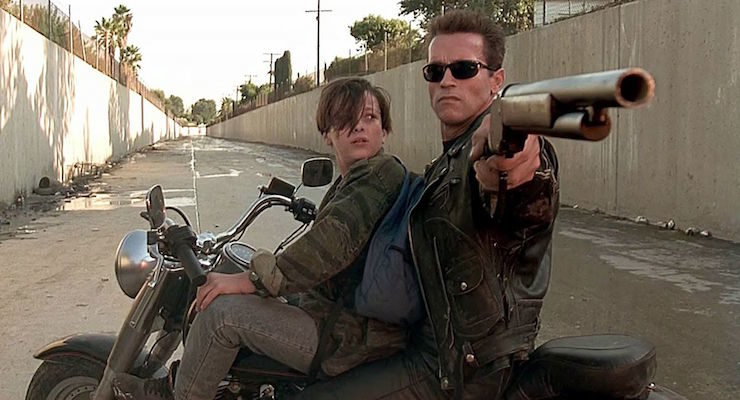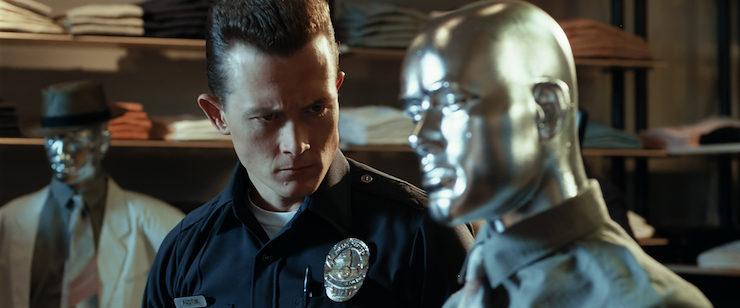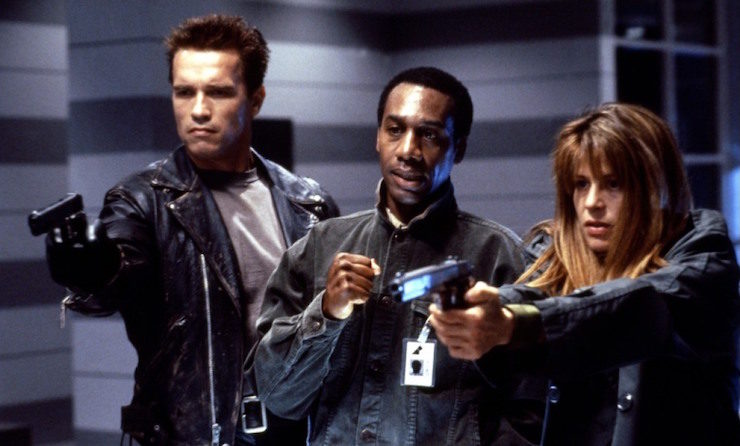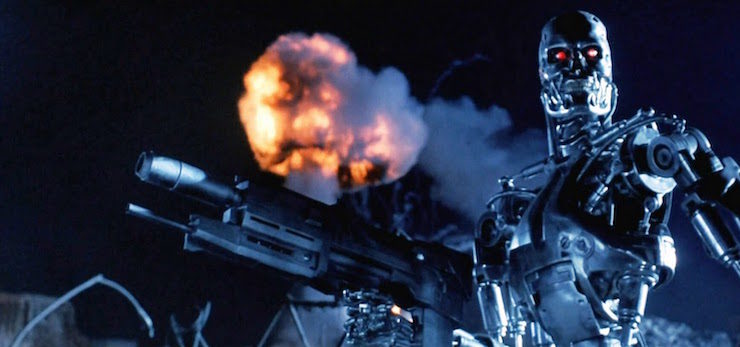Happy belated anniversary of Judgment Day, everyone! August 29th, 1997 was the day that Skynet became self-aware and ended the world, according to 1991’s Terminator 2: Judgment Day. Or at least, it was one of several Judgment Days, depending on which timeline you follow. If there’s one thing the Terminator franchise’s refusal to die has taught us, it’s that the End of the World is a movable feast.
Judgment Day remains a high-water mark for action movies even today and it’s easy to see why. The freeway chase and Cyberdyne sequences in particular are still among the best action scenes Western cinema has ever put on the screen, and you can’t deny either Cameron’s ambition or how well it’s executed in this film. But, the excellence of its many action scenes aside, T2 as a whole has aged in a wildly variable number of ways, and some aspects hold up far, far better than others.
The element that’s held up best over the years is the cast, and perhaps not in ways you’d expect. Linda Hamilton turns in a career-best performance, and the years have only served to enhance our sense of how nuanced, brave, and deliberately unsympathetic a performance it is. After an offhand reference to just how young Sarah was in the original movie (she was 19?!), we meet her again after she’s spent a decade in the underground. Confined at the Pescadero Mental Hospital, this Sarah Connor is no one’s victim. She’s focused, driven, lean. Hamilton’s first appearance on screen is silently doing pull-ups on her overturned bed, her entire body still. It’s a stiff, mechanical series of gestures, and the film is continually at its best when exploring just how like her enemies Sarah has had to become in order to survive and prepare for the future.
Her purity of purpose is the polar opposite of Skynet’s. The insidious A.I. will do anything to kill John, her son, while Sarah will do anything to keep him alive—and that includes becoming as cold and driven as her foe. One of the movie’s best moments comes when she pulls John in for what he thinks is a hug. In reality, she’s methodically checking her son for wounds. It’s one of the times John registers as the ten-year old he’s supposed to be, desperate for his mom’s love and angry and confused when he gets yet another lecture instead of affection and reassurance.

That constant willingness to do the right thing, even if it’s the worst thing, is what drives Sarah and gives the film arguably its best scene. Her attempted assassination of Miles Bennett Dyson shows Sarah attempting to armour herself in the style of her nemesis; her shades, her combat fatigues, her methodical walk, her coldness and single-minded focus. All of it adds up to a woman who has survived incalculable trauma desperately trying to turn that trauma into a weapon. Had the film left her there, it would, for the time, have been iconic. What makes this take on Sarah seem vital even now, though, is her moment of self-realisation. Holding a gun on a badly wounded man as his family try and shield him with their bodies, Hamilton shows us everything going through Sarah’s mind: the rage, the terror, the self-loathing. It all comes crashing down, and Sarah Connor wakes up to herself. It’s an unflinching moment of emotional subtlety (all the more impressive for how little subtlety exists in the rest of the movie), and it allows her to finally close the circuit of her life. Sarah Connor, the terrified but determined 19-year-old, finally returns to Sarah Connor, the terrifying and unstoppable 29-year-old mercenary. She allows herself to become a human being, instead of an automaton unflinchingly protecting an idea, and both she and the movie are vastly improved by both her journey and that moment of self-reckoning.
Hamilton carries Terminator 2 on her back, but she isn’t always alone. Robert Patrick is the great unsung hero of the rest of the cast as the T-1000. Seeming almost impossibly young here, the heavy-set bruiser of shows like Last Resort and The Unit is instead a wiry, precise figure whose physical commitment to the role is as impressive as Hamilton’s. Pay attention to how rarely Patrick blinks; look at how he runs, and the positions he maneuvers his body into. Look at that quarter second pause he metes out during every social engagement that tells us the T-1000 is searching for the best response. It’s a measured, chilling performance that transcends the spectacular special effects that surround it. Just imagine how great it would have been if the trailers hadn’t blown the twist that he was the bad guy, not the guardian sent by the Resistance…
The rest of the cast fare much, much less well from a remove of twenty-six years. Edward Furlong gives a solid performance that’s unfortunately buried under slang that was outdated almost the moment he was filmed saying it, but there’s still a lot to enjoy. Furlong’s John Connor is at his best when he’s actually acting like a kid, his unbroken voice shrieking with terror as a truck driven by a killer machine chases him down. Better still are the moments where he shows us how John has survived the last decade. The idea of the saviour of humanity being a smug little asshole is oddly pleasing even now, and when he’s allowed to act, Furlong does a solid job. The bit where he warns Sarah that the police have arrived—she asks “How many?” and he responds “Uh, all of them, I think.”—still lands really well, too. It’s just a shame that so much of the movie sees him going full pre-apocalyptic Bart Simpson.

Schwarzenegger as an action star is, as ever, fine. Schwarzenegger as an actor is, as ever, terrible. But Schwarzenegger is almost always terrible and is at his best when he makes a virtue of that fact. The T-800 Model 101’s transition from dead-eyed Teutonic automaton to nuclear-powered father figure is one of the film’s weakest points and the 3D conversion currently showing in theaters, which from what I can tell was the original theatrical release, does it no favours. Denied the moment where his chip is switched from READ to WRITE, it casts the Model 101 Terminator as Arnie with some prosthetics on his face, quipping away even as he casually maims people. The moment where he swears, into the camera, that he won’t kill anyone was terrible twenty-six years ago and it has not improved with age. And the ending, especially in the post-Spaced world we now inhabit, is flat out laughable.
Similarly, Joe Morton had a thankless task playing Doctor Miles Exposition, and the years have show just how short-changed he was in the role. Dyson has an amazing arc: he’s a reverse Oppenheimer who rebels against ending the world, while the film steadfastly ignores him. It’s the one area of the movie that’s crying out for more detailed exploration, and Dyson offers an opportunity for a fascinating take on the franchise’s entire world. Instead, Miles is killed and his family are written out without a second look. In 1991, this was annoying. Watching now, it’s actively offensive.
Perhaps the most interesting problem with the film, viewed now, is how it’s built. T2 is Cameron on the cusp of evolving from the relentless special effects craftsman of his early work to the sprawling, Neal Stephenson-like writer of the rest of his career to date. The version I saw last week (on Judgement Day) had no READ/WRITE sequence, as mentioned above, and several of the Terminator’s social interactions, at least two of the T-1000 damage beats, the Kyle Reece cameo and the coda were also missing from the film. It still clocked in at over two hours, and that time was chopped up with (to really belabour the point) mechanical precision.

That’s often a good thing, in terms of pacing. Early scenes showing just how close the two Terminators are to locating John are a great way to ramp up tension. Likewise, Sarah’s escape unfolding as the T-1000 rolls in to kill her while John and the Model 101 swoop in to save her is almost balletic in the way the action plays out. Plus, the full-body freakout that Hamilton undergoes when Sarah sees Schwarzenegger’s Terminator again for the first time in a decade is flat-out brilliant.
But that’s all the movie does. Again and again, its pacing breaks down to “John and the T-800 go somewhere or pursue Sarah somewhere, the T-1000 attacks them, they escape, repeat.” That kind of squeezebox pacing gets predictable after a while, even with Cameron’s willingness to throw every single idea up on the screen.
It’s no accident that the most interesting character work happens during the middle act where the T-1000 temporarily disappears. It’s no slam on Patrick, whose performance is stellar, and admittedly the constant methodical pursuit element of the movie leads to some action sequences that continue to astonish even now, two and a half decades on. But that precision ultimately plays against the movie, especially on more than one viewing. The T-1000 starts to function more like an incredibly violent stagehand at times, clearing the scene and moving us to the next one, rather than an actual villain. It’s a problem that It Follows (2014) also runs into, and the two movies would make a hell of a double bill, if nothing else to see how drastically their approaches differ…
But the element of T2 that still really, truly works is simply that it successfully ends. The relics of the first movie are destroyed (although, in this cut, not the arm the T-800 loses) and the painfully written and solid future is replaced by an unusual moment of visual poetry. The image of the road, still progressing but no one knows where, provides both closure and ambiguity. No one knows where we’re going, we only know that we are moving forward, and that, in this world has to be enough. Not an idyllic happy ending, but the happiest this franchise was ever going to get, and far more successful than the flash-forward that Cameron originally scripted. In fact, Judgment Day fits so well with its predecessor that there’s a strong case to be made for them being two halves of the same finite, definitive story.

But Skynet, and the box office, never rest.
The Sarah Conner Chronicles remains an all-time great series, but not a single one of the big screen sequels that followed Judgment Day has lived up to the first two installments. Worse still, their existence turns Judgment Day into the equivalent of the relics at its heart: an aging but still innovative model being picked clean by scavengers trying to reverse engineer it. In doing so, they might get the surface elements right but ignore the consequences and emotional lessons that define this story, essentially invalidating their own efforts. That’s why they fail, regardless of the escalating scale and spectacular effects, and why, for all its innumerable faults, Judgment Day still succeeds twenty-six years later. Mostly.
Alasdair Stuart is a freelancer writer, RPG writer and podcaster. He owns Escape Artists, who publish the short fiction podcasts Escape Pod, Pseudopod, Podcastle, Cast of Wonders, and the magazine Mothership Zeta. He blogs enthusiastically about pop culture, cooking and exercise at Alasdairstuart.com, and tweets @AlasdairStuart.










